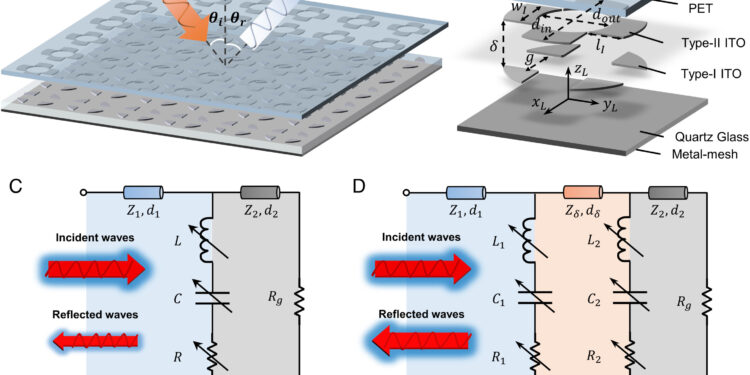The transition of the circuit geometry and topology of the Chimera metasurface. (A) The schematic view of the Chimera metasurface. (B) The geometries of the meta-atom. (C) the high absorption gapless package and (D) the hybrid layer package with tunable interlayer coupling and continuous adaptive reflection. CTN is the abbreviation for circuit topology number. Credit: Proceedings of the National Academy of Sciences (2024). DOI: 10.1073/pnas.2309096120
A multi-institutional team of optoelectronics and materials engineers in China has developed a type of metamaterial that is nearly invisible in the visible light, microwave, and infrared spectra. In their article, published in Proceedings of the National Academy of Sciencesthe group describes their inspiration for the material, how it was made, and how it performed in testing.
The researchers noted that most metamaterials developed to provide some degree of invisibility were designed with one goal in mind: to make it difficult to see a hidden object with the naked eye or with night vision goggles. Instead, they decided to create a unique metamaterial capable of providing multiple types of invisibility. For this, they took inspiration from nature.
The research team noted that the chameleon knows how to hide in visible light. As it blends into the background, it becomes difficult to see. They also noted that glass frogs are difficult to spot because of their transparency. And bearded dragons evolved to hide from predators with thermal-sensing abilities.
Previous research has shown that metamaterials can provide invisibility via surfaces with grooves or bumps designed to reflect electromagnetic waves in a desired way. For this new study, the researchers manipulated their material to reflect visible light, microwave, and infrared spectra in ways that mimicked the chameleon, glass frog, and bearded dragon. They call the result a metamaterial chimera, in reference to the mythical fusion of the three animals they attempted to imitate.
They used a five-step process to layer their material, each with its own characteristics and invisibility attributes. One layer, for example, reflected microwaves, another had circuitry that gave the illusion of transparency, and yet another hid heat emissions using a mechanism to change the color of the metamaterial at times. cooling purposes.
Tests showed that the material worked reasonably well and could likely prove useful for a wide variety of applications, from wildlife studies to military applications.
More information:
Zhao-Hua Xu et al, Metasurface Chimera for multi-terrain invisibility, Proceedings of the National Academy of Sciences (2024). DOI: 10.1073/pnas.2309096120
© 2024 Science X Network
Quote: Metamaterial chimera almost undetectable in visible light, microwave and infrared spectra (February 8, 2024) retrieved February 8, 2024 from
This document is subject to copyright. Apart from fair use for private study or research purposes, no part may be reproduced without written permission. The content is provided for information only.



